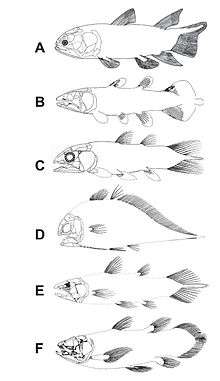Actinistia
| Actinistia Temporal range: Devonian–Recent | |
|---|---|
 | |
| West Indian Ocean coelacanth | |
| Scientific classification | |
| Kingdom: | Animalia |
| Phylum: | Chordata |
| Class: | Sarcopterygii |
| Subclass: | Actinistia Cope, 1871 |
| Daughter taxa | |
| Synonyms | |
| |
Whiteia fossils
Actinistia is a subclass of mostly fossil lobe-finned fishes. This subclass contains the coelacanths, including the two living coelacanths, the West Indian Ocean coelacanth and the king of the sea.
Taxonomy
- Class Sarcopterygii (lobe-finned fishes and tetrapods)
- Subclass Actinistia
- Family Miguashaiidae (Devonian)
- Family Diplocercidae (Devonian and Lower Carboniferous)
- Dictyonosteus
- Diplocercides (Nesides)
- Family Hadronectoridae
- Family Rhabdodermatidae (Primarily Carboniferous)
- Family Laugiidae (Lower Triassic to Lower Cretaceous)
- Order Coelacanthiformes (modern coelacanths and their most recent ancestors)
- Subclass Actinistia
Phylogeny

A, Miguashaia bureaui, Shultze, 1973, Upper Devonian (Frasnian), Migausha, Canada;
B, Diplocercides heiligostockiensis, Jessen (1966), Upper Devonian (Frasnian), Bergisch-Gladbach, Germany;
C, Serenicthys kowiensis gen. et sp. nov., Upper Devonian (Famennian), Grahamstown, South Africa;
D, Allenypterus montanus Melton 1969, Lower Carboniferous (Namurian), Montana, USA;
E, Rhabdodema elegans, (Newberry, 1856), Upper Carboniferous (Westphalian), Linton, Ohio, USA;
F, Latimeria chalumnae Smith 1939, recent, east coast of Africa.
B, Diplocercides heiligostockiensis, Jessen (1966), Upper Devonian (Frasnian), Bergisch-Gladbach, Germany;
C, Serenicthys kowiensis gen. et sp. nov., Upper Devonian (Famennian), Grahamstown, South Africa;
D, Allenypterus montanus Melton 1969, Lower Carboniferous (Namurian), Montana, USA;
E, Rhabdodema elegans, (Newberry, 1856), Upper Carboniferous (Westphalian), Linton, Ohio, USA;
F, Latimeria chalumnae Smith 1939, recent, east coast of Africa.
The following cladograms are based on multiple sources.[1][2][3][4][5]
| | |||||||||||||||||||||||||||||||||||||||||||||||||||||||||||||||||||||||||||||||||||||||||||||||||||||||||||||||||||
| | |||||||||||||||||||||||||||||||||||||||||||||||||||||||||||||||||||||||||||||||||||||||||||||||||||||||||||||||||||
| Actinistia |
| ||||||||||||||||||||||||||||||||||||||||||||||||||||||||||||||||||||||||||||||||||||||||||||||||||||||||||||||||||
| |
| Coelacanthiformes |
| |||||||||||||||||||||||||||||||||||||||||||||||||||||||||||||||||||||||||||||||||
| |
See also
References
- ↑ Wendruff, A. J.; Wilson, M. V. H. (2012). "A fork-tailed coelacanth, Rebellatrix divaricerca, gen. et sp. nov. (Actinistia, Rebellatricidae, fam. nov.), from the Lower Triassic of Western Canada". Journal of Vertebrate Paleontology. 32 (3): 499–511. doi:10.1080/02724634.2012.657317.
- ↑ Gallo, V.; M.S.S. de Carvalho; H.R.S. Santos (2010). "New occurrence of †Mawsoniidae (Sarcopterygii, Actinistia) in the Morro do Chaves Formation, Lower Cretaceous of the Sergipe-Alagoas Basin, Northeastern Brazil". Boletim do Museu Paraense Emílio Goeldi. 5 (2): 195–205.
- ↑ Long, J. A. (1995). The rise of fishes: 500 million years of evolution. Baltimore: Johns Hopkins University Press.
- ↑ Cloutier, R.; Ahlberg, P. E. (1996). Morphology, characters, and the interrelationships of basal sarcopterygians. pp. 445–479.
- ↑ Clement, G. (2005). "A new coelacanth (Actinistia, Sarcopterygii) from the Jurassic of France, and the question of the closest relative fossil to Latimeria". Journal of Vertebrate Paleontology. 25 (3): 481–491. doi:10.1671/0272-4634(2005)025[0481:ancasf]2.0.co;2.
This article is issued from Wikipedia - version of the 10/23/2016. The text is available under the Creative Commons Attribution/Share Alike but additional terms may apply for the media files.